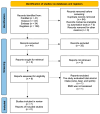Influence of Wine on Bone Mineral Density
- PMID: 40573092
- PMCID: PMC12196265
- DOI: 10.3390/nu17121981
Influence of Wine on Bone Mineral Density
Abstract
Background: Considering the increasing interest in strategies to prevent osteoporosis and other bone-related conditions, it is relevant to critically assess the existing evidence on the potential benefits of phenolic compounds in wine on bone metabolism. Objectives: This integrative review aims to evaluate clinical and animal studies investigating the influence of wine consumption on bone mineral density (BMD). Methods: The search was conducted in PubMed, Scopus, and Embase databases until April 2025. The key question was: "Does wine consumption influence BMD?". Results: After searching the identified databases, 108 studies were screened, and 7 were included in the final analysis. Conclusions: This review suggests a possible association between light to moderate wine consumption and favorable effects on BMD, particularly in the spine and femoral neck. However, these findings should be interpreted cautiously due to the predominance of observational studies. Future RCTs and systematic reviews must clarify wine's potential role in bone health and explore non-alcoholic or low-alcohol wine alternatives with similar polyphenol content.
Keywords: alcohol consumption; alcohol intake; antioxidants; bone density; bone regeneration; bone repair; osteoporosis; polyphenols; wine.
Conflict of interest statement
The authors declare no conflicts of interest.
Figures


Similar articles
-
Effectiveness and safety of vitamin D in relation to bone health.Evid Rep Technol Assess (Full Rep). 2007 Aug;(158):1-235. Evid Rep Technol Assess (Full Rep). 2007. PMID: 18088161 Free PMC article.
-
Influence of psychostimulants on bone mineral density and content among children with attention deficit hyperactivity disorder. A systematic review.Bone. 2024 Feb;179:116982. doi: 10.1016/j.bone.2023.116982. Epub 2023 Nov 24. Bone. 2024. PMID: 38006907
-
Bisphosphonates for steroid-induced osteoporosis.Cochrane Database Syst Rev. 2016 Oct 5;10(10):CD001347. doi: 10.1002/14651858.CD001347.pub2. Cochrane Database Syst Rev. 2016. PMID: 27706804 Free PMC article.
-
Progressive high-intensity resistance training and bone mineral density changes among premenopausal women: evidence of discordant site-specific skeletal effects.Sports Med. 2006;36(8):683-704. doi: 10.2165/00007256-200636080-00005. Sports Med. 2006. PMID: 16869710
-
Nutritional interventions for survivors of childhood cancer.Cochrane Database Syst Rev. 2016 Aug 22;2016(8):CD009678. doi: 10.1002/14651858.CD009678.pub2. Cochrane Database Syst Rev. 2016. PMID: 27545902 Free PMC article.
References
-
- Nemzer B., Kalita D., Yashin A.Y., Yashin Y.I. Chemical Composition and Polyphenolic Compounds of Red Wines: Their Antioxidant Activities and Effects on Human Health—A Review. Beverages. 2022;8:1. doi: 10.3390/beverages8010001. - DOI
-
- U.S. Department of Agriculture and U.S. Department of Health and Human Services . Dietary Guidelines for Americans, 2020–2025. 9th ed. U.S. Government Publishing Office; Washington, DC, USA: 2020.
-
- Lukacs P. Inventing Wine: A New History of One of the World’s Most Ancient Pleasures. WW Norton & Company; New York, NY, USA: 2012.
Publication types
MeSH terms
Substances
LinkOut - more resources
Full Text Sources
Medical
Miscellaneous

